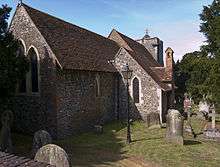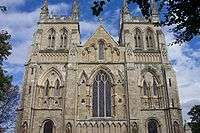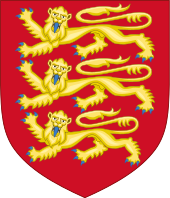Church of England parish church
A parish church in the Church of England is the church which acts as the religious centre for the people within each Church of England parish (the smallest and most basic Church of England administrative unit; since the 19th century sometimes called the ecclesiastical parish, to avoid confusion with the civil parish which many towns and villages have).
 The parish church of St. Lawrence at Bourton-on-the-Water, Gloucestershire, England. |
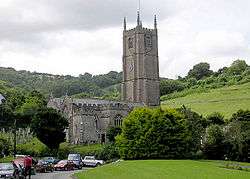 |
Parishes in England
In England, there are parish churches for both the Church of England and the Roman Catholic Church. References to a "parish church", without mention of a denomination, will, however, usually be to those of the Church of England due to its status as the Established Church. This is generally true also for Wales, although the Church in Wales is dis-established.
The Church of England is made up of parishes, each one forming part of a diocese. Almost every part of England is within both a parish and a diocese (there are very few non-parochial areas and some parishes not in dioceses). These ecclesiastical parishes are often no longer the same as the civil parishes in local government. Larger towns and cities, even those with cathedrals, still have ecclesiastical parishes and parish churches.
Each parish is ministered to by a parish priest, usually called a vicar, rector or priest-in-charge. More rarely the parish priest is known as a "perpetual curate". In one instance only the priest is also, by historical custom, officially known as an "archpriest".[1] Each parish usually has one active parish church, though rarely and historically more than one; if there is no parish church, the bishop will usually license another building and may designate it as a Parish Centre of Worship.[2] A parish may also be served by a number of chapels of ease. Unused 'redundant' parish churches may exist in parishes formed by the merging of two or more parishes, or because of the cost of upkeep. These redundant churches may survive as ruins, remain empty, or be converted for alternative uses.[3]

Character
Church of England parish churches include some of the oldest churches to be found in England, often built before the 16th-century reformation, and thus predating the division of Western Christianity. A number are substantially of Anglo-Saxon date, and all subsequent periods of architecture are represented in the country. Most parishes have churches that date back to the Middle Ages, though often with many later additions or alterations. The parish churches of the City of London are particularly famous for their Baroque architecture. Each building reflects its status and there is considerable variety in the size and style of parish churches. Some very large former monastic or collegiate churches are now parish churches, not always in their complete original form. As well as their architecture, many Church of England parish churches are known for their interesting and beautiful church fittings which are often remarkable survivals. These may include monuments, hatchments, wall paintings, stained glass, floor tiles, carved pews, choir stalls (perhaps with misericords), lecterns and fonts, sometimes even shrines or vestments.
The Church of England parish church was always fundamental to the life of every community, especially in rural areas. However, by the late 20th and early 21st centuries, with the decline in the number of worshippers and the shortage of Anglican priests, there has been a trend towards team or shared ministries, and many parish churches no longer have a service every Sunday.
Notable parish churches
_012.jpg)
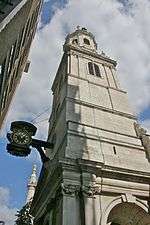
This is a very incomplete list of notable Church of England parish churches:
| Location | Name | Description |
|---|---|---|
| Ashmanhaugh, Norfolk | St. Swithin | The smallest round-tower church in the UK |
| Barton-upon-Humber, North Lincolnshire | St Peter's Church | Good Saxon tower |
| Bedford | St Paul's church | On the site of a former ancient minster, the present medieval 'hall church' was the wartime home of the BBC's The Daily Service. Now the county church with a fine Bodley screen and maintains a choral tradition. |
| Beverley, East Riding of Yorkshire | Beverley Minster | Perpendicular west front, continuous vault, Percy tomb, Hawksmoor font cover, the largest parish church in England by floor area (3489 m2). |
| Bodmin, Cornwall | St Petroc's Church | The church building is late medieval and is the largest parish church in Cornwall. |
| Boston, Lincolnshire | St Botolph's Church | The Stump, lantern interior, 62 misericords. |
| Brent, London | St Gabriel's, Cricklewood | A New Wine church which is home to an historic organ used in BBC Radio recitals. |
| Bristol | St Mary Redcliffe Church | Twin porches, Perpendicular interior, 1,200 roof bosses. |
| Brompton, Kensington, London | Holy Trinity ("HTB") | Evangelical Anglican church where the Alpha course was first developed. |
| Burford, Oxfordshire | St John's Church | Merchants' guild chapel, Red Indian memorial, Kempe glass. |
| Bury St Edmunds, Suffolk | St Mary’s Church | Burial place of Mary Tudor, Queen of France, sister of Henry VIII, second longest aisle of a Parish Church in England. Hammer beam roof with carved angels. Has a traditional robed choir which has existed for hundreds of years. |
| Canterbury, Kent | St Martin's | Oldest surviving Church of England parish church of English origin |
| Christchurch, Dorset | Christchurch Priory | Norman exterior, Decorated screen, Perpendicular tombs and chantries. |
| Cirencester, Gloucestershire | St John the Baptist's Church | Perpendicular porch, fan vaults, merchants' tombs. |
| City of London | St Magnus the Martyr | Wren church situated at the end of the old London Bridge. |
| Crediton, Devon | Crediton Parish Church | A former collegiate church which was rebuilt in the 15th century and has some fine monuments. |
| Culbone, Somerset | St Culbone's Church | Smallest parish church in England. |
| Doncaster | St George's Minster | "South Yorkshire's most majestic building". |
| Earls Barton, Northamptonshire | All Saints' Church | |
| Fairford, Gloucestershire | St Mary's Church | Complete set of medieval glass, stone carvings, misericords. |
| Gawber, Barnsley | St Thomas the Apostle | A small church in South Yorkshire |
| Grantham, Lincolnshire | St Wulfram's Church | Steeple and west front, Decorated tracery, Corbel-table carvings. |
| Hull, Yorkshire | Holy Trinity Church | The fourth-largest parish church in England by floor area (2473 m2). |
| Kendal, Cumbria | Holy Trinity Church | Claims to be the widest parish church in England |
| Leeds | Minster and Parish Church of St Peter | Leeds has no Anglican cathedral, so the Minster has several administrative functions below those of Bradford, Ripon and Wakefield Cathedrals. |
| Liverpool | Our Lady and St Nicholas | Liverpool's 'sailors' church', traditional emigrants' landmark on leaving for the New World |
| Long Melford, Suffolk | Holy Trinity Church | Richest East Anglian church, Clopton Chantry, Lily Crucifix, medieval glass. |
| Ludlow, Shropshire: | St Laurence's Church | Medieval Palmers' glass, Pietà bench-end, civic tombs. |
| Maidenhead, Berkshire | St Luke's Church | Largest church in Maidenhead |
| Ottery St Mary, Devon | Miniature Exeter Cathedral, painted roof, fan-vaulted aisle. | |
| Patrington, East Riding of Yorkshire | St Patrick's Church | Octagonal tower top, Decorated carvings throughout. |
| Pershore, Worcestershire | Pershore Abbey | Former abbey restored by George Gilbert Scott |
| Plymouth, Devon | St Andrew's Church | Rebuilt after World War II |
| Selby, North Yorkshire | Selby Abbey | Norman nave, chancel stiff-leaf, east window tracery with medieval glass. |
| Sherborne, Dorset | Sherborne Abbey | Complete fan vault, carved bosses, misericords. |
| Tewkesbury, Gloucestershire | Tewkesbury Abbey | Norman nave, 'Sun of York' bosses, Despenser tombs, medieval glass. |
| Walpole St Peter, Norfolk | St Peter's Church | Nave woodwork, font cover, 'bolt-hole' tunnel. |
| Warwick, Warwickshire | St Mary's Church | Beauchamp Chapel and tombs. |
| Westminster, London | All Saints, Margaret Street | Anglo-Catholic shrine. |
| Westminster, London | St Margaret's | The parish church of the British Houses of Parliament |
See also
- Churches Conservation Trust
- Historical development of Church of England dioceses
- Architecture of the medieval cathedrals of England
- Stained glass - British glass, 1811-1918
- Greater Churches Group
References
- Haccombe in Devon. Notes and Queries, no.321
- "Mission and Pastoral Measure 2011, s.43". legislation.gov.uk. Retrieved 9 October 2015.
- Lichfield Diocese Archived 16 July 2011 at the Wayback Machine
- Pevsner, N.; et al. (1951–74). The Buildings of England (46 vols.). Harmondsworth: Penguin Books.
- Jenkins, Simon (1999). England's Thousand Best Churches. photog. Paul Barker. London: Allen Lane. ISBN 0-7139-9281-6.
- Morris, Richard (1989). Churches in the Landscape. London: J. M. Dent & Sons.
